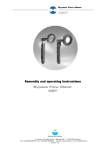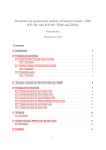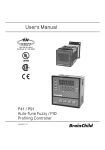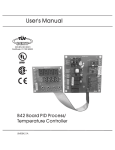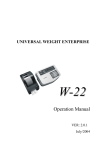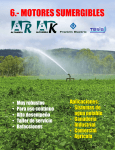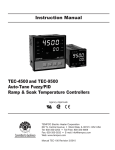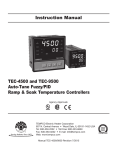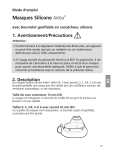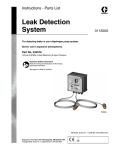Download Assembly and operating Instructions Bypass Flow Meter DST
Transcript
Bypass Flow Meter DST Assembly and operating Instructions Bypass Flow Meter DST A. Kirchner & Tochter GmbH Dieselstraße 17 · D-47228 Duisburg Fon: +49 2065 9609-0 · Fax: +49 2065 9609-22 Internet: www.kt-flow.de · e-mail: [email protected] Version 1.4 Bypass Flow Meter 2 DST Contents 1. 2. Foreword............................................................................................................................................................... 3 Safety...................................................................................................................................................................... 3 2.1. Symbol and meaning............................................................................................................................. 3 2.2. General safety directions and exemption from liability......................................................... 3 2.3. Intended use ............................................................................................................................................. 3 2.4. Safety information for Operator and operating personnel................................................. 3 2.5. Special safety information concerning glass devices............................................................ 4 2.6. Regulations and guidelines ................................................................................................................ 4 2.7. Information in compliance with the hazardous materials directive................................ 4 3. Handling and storage ..................................................................................................................................... 4 4. Installation ............................................................................................................................................................ 5 4.1. Pre-assembly ............................................................................................................................................ 5 4.2. Preparatory work ................................................................................................................................... 5 4.3. Installation of the bypass flow meter DST .................................................................................. 6 De-airing: DST, DST with contacts............................................................................................................ 6 5. Start-up.................................................................................................................................................................. 6 6. Readings in operation..................................................................................................................................... 6 7. Limit switches MSK-1 / MSK-12 ............................................................................................................. 7 7.1. Connection of limit switches.............................................................................................................. 7 7.2. Setting the limit switches.................................................................................................................... 7 8. Linear displacement sensor 4-20mA / 0-10V.................................................................................. 7 8.1. Connection of the linear displacement sensor......................................................................... 8 8.2. Setting the linear displacement sensor....................................................................................... 9 8.3. Technical data....................................................................................................................................... 10 9. Maintenance of the flow meter............................................................................................................... 11 10. Service ........................................................................................................................................................... 12 Disposal .................................................................................................................................................................. 12 11. Technical data............................................................................................................................................ 13 Versions ............................................................................................................................................................. 13 Technical data of limit switches.............................................................................................................. 15 A. Kirchner & Tochter GmbH Dieselstraße 17 · D-47228 Duisburg Fon: +49 2065 9609-0 · Fax: +49 2065 9609-22 Internet: www.kt-flow.de · e-mail: [email protected] Version 1.4 Bypass Flow Meter 3 DST 1. Foreword These Installation and Operating Instructions apply to series DST bypass flow meters. Please follow and observe all instructions and information for installation, operation, inspection and maintenance. The Instructions form a component part of the device, and should be kept in an appropriate place accessible to personnel in the vicinity of the location. Where various plant components are operated together, the operating instructions pertaining to the other devices should also be observed. 2. Safety 2.1. Symbol and meaning Safety notice This symbol is placed against all directions/information relating to occupational health and safety in these Installation and Operating Instructions, and draws attention to potential danger to life and limb. Such notices must be strictly observed. 2.2. General safety directions and exemption from liability This document contains basic directions for the installation, operation, inspection and maintenance of the bypass flow meter. Non-observance of these directions can lead to hazardous situations for man and beast and also to damage to property, for which Kirchner und Tochter disclaims all liability. The operator is required to rule out potentially hazardous situations through voltage and released media energy. 2.3. Intended use The DST bypass flow meters are designed and intended for measuring the flow of compressible and incompressible fluids. They may only be installed in the pipeline between flanges. Select the DST device model on the basis of the nominal diameter and nominal pressure at the site and also the kind of medium concerned; limit values are specified in the Section "Technical Data" and should not be exceeded. 2.4. Safety information for Operator and operating personnel Authorized installation, operating, inspection and maintenance personnel should be suitably qualified for the jobs assigned to them, and should receive appropriate training and instruction. A. Kirchner & Tochter GmbH Dieselstraße 17 · D-47228 Duisburg Fon: +49 2065 9609-0 · Fax: +49 2065 9609-22 Internet: www.kt-flow.de · e-mail: [email protected] Version 1.4 Bypass Flow Meter 4 DST 2.5. Special safety information concerning glass devices For safety reasons, we recommend fitting a protective shield in front of the measuring tube when operating flow meters with glass measuring tubes. The devices should not be operated where there is risk of pressure surges! 2.6. Regulations and guidelines In addition to the directions given in these Installation and Operating Instructions, observe the regulations, guidelines and standards, such as DIN EN, and, for specific applications, the codes of practice issued by DVGW (gas and water) and VdS (underwriters), or the equivalent national codes, and applicable national accident prevention regulations. 2.7. Information in compliance with the hazardous materials directive In accordance with German legislation concerning waste disposal (critical waste) and the hazardous materials directive (general duty to protect), we would point out that all flow meters returned to Kirchner und Tochter for repair are required to be free from any and all hazardous substances (alkaline solutions, acids, solvents, etc.). Make sure that devices are thoroughly flushed out to neutralize hazardous substances. 3. Handling and storage Always use the original packing for transport, handling and storage. Protect the device against rough handling, impact, jolts, etc.! A. Kirchner & Tochter GmbH Dieselstraße 17 · D-47228 Duisburg Fon: +49 2065 9609-0 · Fax: +49 2065 9609-22 Internet: www.kt-flow.de · e-mail: [email protected] Version 1.4 Bypass Flow Meter 5 DST 4. Installation 4.1. Pre-assembly Make sure that the nameplate on the metering orifice has the same number as that on the bypass flow indicator. 1. Place the O-rings in the O-ring groove. 2. As the next step, scrw the bypass flow indicator to the DST ring. DST ring Bypass flow indicator O-rings 3. Finally, align the DST ring with the bypass flow indicator so that both arrows point in the same direction of flow of the device. 4.2. Preparatory work Make preparations for inter-flange mounting by having ready the flanges and assembly materials. Provide for a distance between the mounting flanges that is equivalent to the ring thickness plus 2 x the thickness of the gaskets you intend using. The unimpeded straight pipe inlet/outlet runs (A) should be 4 - 6 x DN upstream and downstream of the installation point. The direction of flow through the variable-area flow meter must be from bottom to top. On water service, the indicator is installed in suspended arrangement and on air service in standing arrangement to avoid accumulation of air and condensation of water. To avoid errors, the orifice plate ring is marked with an arrow pointing in the direction of flow (the arrow is punched into metal rings and stuck on to plastic rings). A. Kirchner & Tochter GmbH Dieselstraße 17 · D-47228 Duisburg Fon: +49 2065 9609-0 · Fax: +49 2065 9609-22 Internet: www.kt-flow.de · e-mail: [email protected] Version 1.4 Bypass Flow Meter 6 DST 4.3. Installation of the bypass flow meter DST Before installing the device, drain the pipes. Observe the maximum pressure and maximum temperature levels. The direction of flow must be the same as the direction indicated by the arrow on the orifice plate ring of the device. Use gaskets made of rubber or SIL, for plastic devices use only gaskets made of rubber with a Shore hardness A of approx. 65°. The gaskets should not project into the pipe and the measuring device must be fitted in line with the pipe axis, as otherwise measurement results would be falsified. For orifice plate rings made of PVC, PP and PVDF, tighten screw connections only with a maximum torque of 75 Nm, the device ring could break otherwise. Mount the orifice plate ring for the device between the flanges at the point of installation. De-airing: DST, DST with contacts The devices must be completely de-aired: at the maximum possible volume rate of flow in the main pipe, open and then close the ball cock in the bypass behind the outlet of the VA flow meter. Slacken the 1½“ union nut on the square head of the bypass line (making sure that both Orings remain securely in the head) until water flows and the air escapes. If possible, operate the flow meter at full power or more. Should this not prove to be possible, continue the procedure for some time until it is quite certain that all air has been evacuated. 5. Start-up The device must be properly installed before it is started up. Pressurize the measuring line. Avoid pressure surges. Check the leak-tightness of the inter-flange connection and, if necessary, tighten down the screw connection. With varying volume rates of flow, starting at maximum value, test the local indicator on the device. 6. Readings in operation The flow value is read off from the scale on the glass cone against the top edge of the float. Readings are only correct when flowing conditions at the measuring point (flowing medium, operating pressure and temperature) correspond to the values marked on the measuring glass. If conditions should differ, the device will need to be recalibrated by Kirchner und Tochter. A. Kirchner & Tochter GmbH Dieselstraße 17 · D-47228 Duisburg Fon: +49 2065 9609-0 · Fax: +49 2065 9609-22 Internet: www.kt-flow.de · e-mail: [email protected] Version 1.4 Bypass Flow Meter 7 DST 7. Limit switches MSK-1 / MSK-12 The flow meter can be equipped with a limit switch to provide the local indicator with a monitoring function. This consists of a limit contact that is operated by a magnet integrated in the float. The switch is guided in a guiding slot on the rear side of the protective casing and can be adjusted over the full measuring range. The switching performance is bistable. Uncontrolled current and voltage peaks can occur in the case of inductive or capacitive loads, e.g. from contactors or solenoid valves. Such peaks will also occur, depending on cable geometry, where cables exceed a certain length. We therefore recommend using an MSR contact protection relay, which is additionally available. This will increase the contact rating and prevent occurrence of inductive and capacitive peaks, thus ensuring a long contact service life. 7.1. Connection of limit switches Electrical connection of the device should be carried out in conformity with the relevant VDE regulations, or equivalent national standards, and in accordance with the regulations issued by the local power supply utility. Before connecting the limit switch, ensure that the plant is disconnected from supply. Provide a protective circuit for the switches in keeping with their rating. Connect appropriate line-side fuse elements based on consumption. Connect the cable to the supplied right-angle plug. Assigned are terminals 1 and 2. Earth and terminal 3 are not assigned. The circuit diagram for the limit switches is shown in the Technical Data, Section 10 on page 15. 7.2. Setting the limit switches Detach the lock nut M8 located on the neck of the switch. Slide the switch to the flow value required to be monitored Please make sure the contact never touches the measuring glass and the clearance between contact and glass is always approx. 1mm. This clearance can be obtained by turning the contact in the sliding block. Test the switching performance by moving the float beyond the switching position. Fasten the lock nut finger-tight. Maximum fastening torque is 2 Nm. 8. Linear displacement sensor 4-20mA / 0-10V Operating principle: The linear displacement sensor based on the Hall principle delivers an output signal proportional to the height setting of the flow meter. The can be displayed in 4-20mA or 0-10V. The sensor is connected via the enclosed M12 x 1mm connector. Please notice that the sensor has a blind zone in the range of 3.7mA to around 4 mA and performs stable operation only after approx. 4mA. A. Kirchner & Tochter GmbH Dieselstraße 17 · D-47228 Duisburg Fon: +49 2065 9609-0 · Fax: +49 2065 9609-22 Internet: www.kt-flow.de · e-mail: [email protected] Version 1.4 Bypass Flow Meter 8 DST 8.1. Connection of the linear displacement sensor The electrical connection of the device must be performed according to the pertinent VDE regulations, as well as the regulations of the local power company. 1. Disconnect electric power from the system before connecting the sensor. 2. Provide a protective circuit of the sensor corresponding to its output. 3. Connect the protective elements suitable for use upstream. 4. The cable connection is done on the enclosed angle connector. The circuit diagram for the sensor is in the following illustration: circuit diagram: pin assignment: A. Kirchner & Tochter GmbH Dieselstraße 17 · D-47228 Duisburg Fon: +49 2065 9609-0 · Fax: +49 2065 9609-22 Internet: www.kt-flow.de · e-mail: [email protected] Version 1.4 Bypass Flow Meter 9 DST 8.2. Setting the linear displacement sensor Normally the linear displacement sensor is delivered set on the lowest measurement range point. This corresponds in this condition to 4mA. The other measurement range or mA values can be found in the enclosed protocol. If you want to set the 4 mA value to another measurement range point, slide the sensor or the 4mA value to the desired point. To do this, loosen the two outer nuts with their toothed washers. Next loosen the two setscrews by approx. one revolution. Now you can put the sensor in the desired position, and retighten the setscrews and the nuts. Next move to each following scale mark to determine the mA value belonging to it. A. Kirchner & Tochter GmbH Dieselstraße 17 · D-47228 Duisburg Fon: +49 2065 9609-0 · Fax: +49 2065 9609-22 Internet: www.kt-flow.de · e-mail: [email protected] Version 1.4 Bypass Flow Meter 10 DST 8.3. Technical data Measurement range [A...B] Repeatability Linearity deviation Temperature drift Ambient temperature 160 mm < 0.1 % from measurement range IA-BI < dependent upon position sensor <1 % v. E. <±0.006%/K -25...+ 70 °C Operating voltage Residual ripple Idle current l0 Rated insulation voltage Short circuit protection Fail-safe circuit / reverse polarity protection Output function Voltage output Current output Load resistor voltage output Load resistor current output Recovery time at output Sampling rate 15 – 30 VDC < 10 % Uss < 15 mA < 0.5 kV yes yes/ complete four-wire, analogue output 0... 10V 4 – 20 mA >4.7 k <0.4 k < 15 ms 200 Hz Type Dimensions Housing material Material of active surface Connection Vibration resistance Shock resistance Protection class Quader, Q25L 201 x 35 x 25 mm Aluminium Plastic, PC-GF20 Plug connector, M12x1 55 Hz(1 mm) 30g (11 ms) IP67 Operating voltage display Measurement range display LED green LED, yellow, position sensor in detection range A. Kirchner & Tochter GmbH Dieselstraße 17 · D-47228 Duisburg Fon: +49 2065 9609-0 · Fax: +49 2065 9609-22 Internet: www.kt-flow.de · e-mail: [email protected] Version 1.4 Bypass Flow Meter 11 DST 9. Maintenance of the flow meter The device is maintenance-free. A. Kirchner & Tochter GmbH Dieselstraße 17 · D-47228 Duisburg Fon: +49 2065 9609-0 · Fax: +49 2065 9609-22 Internet: www.kt-flow.de · e-mail: [email protected] Version 1.4 Bypass Flow Meter 12 DST 10. Service All devices with defects or deficiencies should be sent direct to our repair department. To enable our customer service facility to deal with complaints and repairs as quickly as possible, you are kindly requested to coordinate the return of devices with our sales department, Tel. +49 (0) 2065-96090. Disposal Please help to protect our environment, and dispose of workpieces in conformity with current regulations or use them for some other purpose. A. Kirchner & Tochter GmbH Dieselstraße 17 · D-47228 Duisburg Fon: +49 2065 9609-0 · Fax: +49 2065 9609-22 Internet: www.kt-flow.de · e-mail: [email protected] Version 1.4 Bypass Flow Meter 13 DST 11. Technical data Versions Version DST-PVC Ring PVC Orifice plate PVC Valves PVC DST-PP PP PP PP DST-PVDF PVDF PVDF Polysulphone / PVDF can be supplied without valves Bypass PVC PP PVDF RA 77 / PSU PSU / RA 87 Indicator 1) RA 77 / PSU Meas. glass Borosilicate glass / Borosilicate glass / Borosilicate glass / opt. Polysulphone opt. polysulphone optionally Float PVC, optionally PP, optionally PVDF, optionally 1.4571 steel, PTFE 1.4571 steel, PTFE 1.4571 steel, PTFE Gaskets EPDM, opt. Viton EPDM, opt. Viton Viton, optionally Max. temp. / 20°C at 10 bar 20°C at 10 bar 20°C at 10 bar pressure 40°C at 6 bar 70°C at 2,5 bar 80°C at 5 bar 80°C at 1.5 bar 100°C at 4 bar DST 1/2 Steel, grade 1.4301 steel Brass, nickeplated DST-V4A 1.4571 steel 1.4571 steel 1.4571 steel Steel, galvanized RA 65 Borosilicate glass 1.4571 steel RA 87 Borosilicate glass Water: 1.4305 Air: Al anodized NBR 20°C at 10 bar Special version: 80°C at 5 bar Water: 1.4571 steel Air: Teflon Viton 20°C at 10 bar Special version: 80°C at 5 bar Measuring ranges (DST, DST-MSK-1, DST-MSK-12) DN Measuring range H O m /h 0.02 - 0.16 3.5 - 25 0.02 - 0.16 4 - 30 0.02 - 0.16 4.5 - 40 1.2 - 2.7 7 - 60 1.2 - 3.3 13 - 100 3-7 25 - 200 8 - 15 40 - 300 14 - 30 55 - 380 30 - 75 90 - 650 43 - 140 150 - 680 75 - 250 170 - 665 130 - 500 300 - 1800 1 3 2 32 40 50 65 80 100 125 150 200 250 300 400 1 Max. pressure drop in hPa 150 300 150 350 150 550 36 550 51 350 58 430 30 350 42 500 42 500 90 270 84 360 140 280 Measuring range air m /h at STP 0.15 - 1.5 35 - 200 0.15 - 1.5 35 - 200 0.15 - 1.5 49 - 300 12.5 - 30 78 - 535 14 - 30 150 - 1010 30 - 70 280 - 1750 95 - 200 470 - 2850 185 - 400 640 - 3850 380 - 790 1125 - 6000 390 - 800 1200 - 6000 390 - 800 1200 - 6000 3 2 Max. pressure drop in hPa 68 38 68 38 68 38 6 55 6 50 6 60 6 60 7 53 6 69 7 70 7 70 - Refer to relevant Data Sheet 2 In each case the minimum and the maximum measuring range are specified. Please ask for our detailed "DST-DN and measuring ranges" Table. Measuring ranges for other process media and operating conditions available on request A. Kirchner & Tochter GmbH Dieselstraße 17 · D-47228 Duisburg Fon: +49 2065 9609-0 · Fax: +49 2065 9609-22 Internet: www.kt-flow.de · e-mail: [email protected] Version 1.4 Bypass Flow Meter 14 DST Dimensions DN d4 A B C3) 3) 32 40 50 65 80 100 125 150 200 250 78 88 102 122 138 158 188 212 268 320 160 160 160 160 160 160 160 160 160 160 DST-PVC 500 mm, DST-PP 528 mm, DST-PVDF 555 mm, DST-1/2 543 mm 50 50 50 50 50 50 50 50 50 50 300 400 370 482 160 160 50 optionally: special overall lengths possible A. Kirchner & Tochter GmbH Dieselstraße 17 · D-47228 Duisburg Fon: +49 2065 9609-0 · Fax: +49 2065 9609-22 Internet: www.kt-flow.de · e-mail: [email protected] Version 1.4 50 Bypass Flow Meter 15 DST Technical data of limit switches Design Voltage switched Current switched Contact rating Dielectric strength Temperature range Switching function Connection MSK1 50VAC/75VDC 0,5A 10W/VA 230VAC/400VDC -20 to +90°C normally closed contact Design Voltage switched Current switched Contact rating Dielectric strength Temperature range Switching function Connection MSKW 50VAC/75VDC 0,5A 5W/VA 110VAC/200VDC -20 to +90°C change over contact 1) MSK12 50VAC/75VDC 0,5A 10W/VA 230VAC/400VDC -20 to +90°C normally open contact The deciding factor is the thermal endurance of the flow meter! Connection via right angle plug M12x1 A. Kirchner & Tochter GmbH Dieselstraße 17 · D-47228 Duisburg Fon: +49 2065 9609-0 · Fax: +49 2065 9609-22 Internet: www.kt-flow.de · e-mail: [email protected] Version 1.4 Bypass Flow Meter DST The equipment from Kirchner und Tochter has been tested in compliance with applicable CE-regulations of the European Community. The respective declaration of conformity is available on request. Technical data supplied without liability. The current valid version of our documents can be found under this URL: www.kt-flow.de The Kirchner und Tochter QM-System is certified in accordance with DIN-EN-ISO 9001:2008. The quality is systematically adapted to the continuously increasing demands. A. Kirchner & Tochter GmbH Dieselstraße 17 · D-47228 Duisburg Fon: +49 2065 9609-0 · Fax: +49 2065 9609-22 Internet: www.kt-flow.de · e-mail: [email protected] Version 1.4
















